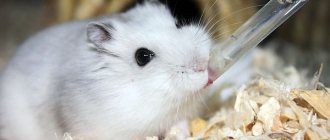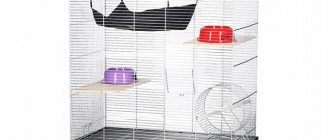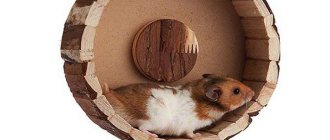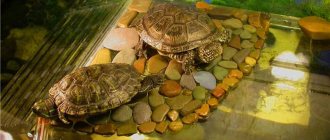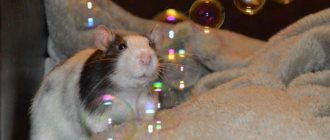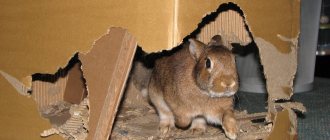- home
- Housing
03.11.2018 Toys for hamsters are essential items. The health of these restless, fussy animals is inextricably linked with physical activity. In order for your little pet to spend his leisure time beneficially “for body and soul,” you should make sure that the hamster has a sufficient number of interesting toys. Many sports and entertainment devices are presented in pet supply stores. But if their price does not fit into the owner’s budget, in order not to leave the animal without joy and a reason for training, you can make useful toys for the hamster with your own hands.
Hamster toys
Hamsters living in the wild are constantly on the move. They are forced to look for food, run away and hide from enemies. For domestic animals there is no need for this - there is food, there are no attacks from predators. But a life of safety and prosperity does not relieve hamsters of the need for activity. In order for your pet not to become “fat” and to remain vigorous and healthy, it is necessary to provide him with proper leisure time. The best option is active games. Special devices are designed to help organize them.
Toys for animals should be focused on finding treats and movement. These tasks can be either combined in one multifunctional device or distributed among different devices - monofunctional.
The first include devices containing “hard-to-get” treats. To get to a tasty prize, the hamster will have to try hard - run, rummage, climb, etc. These are any structures where you can hide a treat for the furry champion. Even stairs are included in this category, as the prize can be placed on the top step.
Other toys that do not have a place to hide treats are exclusively sports equipment - these are running wheels, etc. Of course, multifunctional toys can only be used as exercise equipment. But it is important to remember that the animal must have an incentive to exercise. And there is no better incentive for a hamster than the alluring aroma of a treat.
Choosing the right cage
Buying an animal begins with purchasing an “apartment”. Let's figure out what a hamster cage should be like in order to balance the appropriate living space and meet the standards of a healthy living environment.
- Size. You need a cell of a certain area. Too small - all the necessary accessories will not fit inside; too large - the animal will feel discomfort.
- Base. The solid plastic bottom with rounded corners makes cleaning much easier, and dirt can remain in the pull-out tray.
- Rods. The ideal option would be metal, unpainted rods made of high-quality metal, with a frequent arrangement of cells. A hamster living in a cage with too wide openings between the bars will definitely escape.
- Door. Despite its small size, the animal is quite strong; the exit must have a reliable lock that the animal is not able to open or bend. If the cage has two floors, doors should be located on each. This will make it easier to clean and catch the animal if necessary.
If you first got a male, and then plan to get another female, you will need large housing. This is usually achieved by adding a second floor, rather than by having an impressive footprint. By purchasing such a cage, you can save money by not purchasing factory accessories.
Let's look at how to make the second floor of a hamster cage yourself. A lot of improvised items are used for production. The only condition is the absence of sharp parts that could injure the animal. It is necessary to make a platform and a ladder to it.
It is desirable that both surfaces are solid, without holes where a hamster's paw could fall through. Be sure to firmly fasten, or better yet glue, all the parts, because the animal is quite energetic and can knock them over or knock them over during play. The good thing about making it yourself is that you can fix a broken part without investing money.
You can also make nesting houses for hamsters with your own hands, where they store supplies, rest or sleep. To do this, you will need objects without sharp elements, with which you can create a cozy corner. Be sure to make several ventilation holes of small diameter so that the animal cannot crawl through them.
Delicious "walnut" staircase
From the empty shells of several walnuts you can make an excellent toy for your pet. In addition to the empty shell halves, you need to prepare in advance:
- a thin nail with a sharp end;
- hammer;
- a strong thread as long as the height of the cell;
- medium size washer.
In all prepared half-shells, you need to carefully make a hole in the center. This is done by driving a nail (there is no need to leave it in the resulting hole). You need to thread a thread through the holes to make the shells into a kind of beads. An important nuance - all halves must be turned in one direction, with the exception of the last one. In a vertical position, the beads look like a stack of bowls standing on a tubercle.
A washer is tied to the end of the thread coming out of the last (lower) shell so that the thread is securely fastened and the structure does not fall apart. The upper end of the thread is tied to the “ceiling” of the cage so that the lower shell lies on the bottom, but the “beads” do not sag. You need to put treats for the hamster in all the resulting bowls. Climbing the structure, the pet will take away a tasty prize at each stage of “conquering the peak”.
The height of the structure must be respected. Hamsters climb beautifully, but they descend simply by jumping. Therefore, you should not use shells from more than several nuts for one construction. In addition, it is important to provide your pet with a soft landing - the bedding in the area of the toy should be thick.
Types of hamsters that can be kept at home
Of the variety of hamsters, only a few species are kept at home.
Below are the most common domestic hamsters and their photos.
Pre-Asian hamster
The most popular species for keeping at home is the Central Asian or Syrian hamster (Mesocricetus auratus). Very little is known about its life in the wild. In 1839, the first representative of this species was described, found in the Syrian desert. For a long time it was believed that the pre-Asian hamster was extinct, but in 1930 a female and her litter were captured in Syria and then taken to Israel. A single family in captivity quickly multiplied, and the species was introduced to pet owners in the 1940s.
Today the Syrian hamster is one of the most popular pets.
He is quite unpretentious, has a calm character, and what is very important, rarely gets sick
The body length of the Syrian hamster does not exceed 14 cm, and its weight is 250 grams. The animal's tail is so short that it is practically invisible due to its fur. Its natural color is golden, although breeders have developed a large number of color variations: if desired, it is not difficult to find white, beige, gray and even black animals. In addition to the solid-colored varieties, patterned types have been developed: tortoiseshell (with large white, yellow spots, and tricolor), with a white belt around the body, and spotted. Eyes may be black, red or pink.
However, breeders went further and bred animals with three other types of coat, each of which can have different colors.
In the photo below, the so-called “Angora” hamster is essentially the same Syrian, only long-haired.
The Syrian hamster, with its thick, tousled, wavy fur and curly mustache, is called the royal hamster.
With the satin type, the coat is short, smooth, and surprisingly shiny.
Djungarian hamster
Another popular species for home keeping is the Djungarian hamster (Phodopus sungorus). It is smaller in size than the Syrian (its body length is 7-10 cm), but is even more active at night.
The external feature of this species is a narrow black stripe running along the animal’s spine. Its coat is not very long, with white patches.
Roborovsky's hamsters
This dwarf species has a body length of no more than 5 cm, the tail is hidden in a thick fur coat. The fur of the Roborovskiy hamster (Phodopus roborovskii) is golden sandy in color; A characteristic feature is the white brow ridges in the form of a mask. In nature, they live in Mongolia and Northern China.
They are great pets to watch, however, they are not as friendly as Syrians and are more difficult to communicate with. They are very nimble, can make amazing jumps, but are not able to sit on their hands for even a second.
And if it is better to keep Syrian and Djungarian hamsters one at a time, since in a confined space they will fight among themselves, then Roborovsky hamsters can be kept in pairs and groups - they are not aggressive towards their relatives.
Campbell's hamster
These hamsters are similar in appearance to Djungarian hamsters, differing from them in a thinner and more diffuse stripe on the back. In addition, Campbells (Phodopus campbelli) can be spotted, and their fur is not smooth, but in tufts.
In nature, they are found in Kazakhstan, Mongolia, and northern China. In Russia they inhabit Transbaikalia, Buryatia and Tuva.
Thanks to breeders, domestic Campbells can have a variety of colors; in nature, the color of their fur coat is dark gray with a brownish tint.
Cardboard ball with surprise
You can make a kind of hamster “kinder surprise” from cardboard toilet paper rolls. Essentially, it is a ball with a treat hidden inside. It is well suited as a multifunctional toy for Djungarian hamsters and other tiny breeds. Large animals like the Syrians will deal with the toy faster than necessary. All you need to make this useful homemade product:
- cardboard sleeves;
- scissors;
- treat.
The bushings are cut into identical rings. A standard sleeve makes 5 rings - this is usually what is required for one toy. Two rings are threaded crosswise into one another. A tasty reward is placed inside, then another ring is put on top and another until the cardboard ball becomes tight.
The toy is ready. It will captivate the little restless explorer for a long time. The hamster will “chase” this ball, will definitely try it on its teeth, and so on until it reaches the final goal - it will pull out the treat.
Making simple tunnels
A hamster cage must contain at least one small tunnel. And for games outside the home, complex structures of medium and large size are suitable. You can make a permanent entertainment room for your furry friend or build the attraction anew each time, changing its size and direction of moves.
Children are showing great interest in creating entertainment for hamsters. We invite you to study the instructions for creating simple tunnels that even a schoolchild will understand.
Paper tube for cage
The simplest option is to use a cardboard paper towel tube as a building material. You can put it in the cage unchanged or make windows in the tube so that the animal can come out through them.
The sleeve tube can also be installed in external cardboard labyrinths.
Game room
Do your kids love to play with and watch hamsters? Then give them an idea: make a tunnel for a hamster from an unnecessary cardboard box. The kids will happily get down to business, use their creative imagination and create an attraction with love.
There are a lot of construction options. We will tell you how to make a hamster maze in two different ways.
- The first method does not involve the use of glue. Take a box and pieces of cardboard: 3 strips should correspond in size to the length of the room, 5 to the width. On long pieces, make 5 cuts at equal distances from each other, and cut short pieces three times. Between the cuts, cut out doors, windows and holes for pipes. Now we can assemble our room. Install long partitions with the cuts up, and insert short parts into them with the cut down. You will get a lattice. If you have pipes planned, insert them into the round cutouts. Place the grid in the box and you can start playing right away!
- The second method is based on gluing the walls. It is good because you can create a variety of branches, as well as a rest room for a small creature. To glue the walls, use regular or construction tape.
Labyrinth from a construction set
Preschoolers and schoolchildren love to build various castles and fortresses from construction sets. Invite them to make an attraction for a hamster - they will happily complete this task. Moreover, children themselves know how to make a labyrinth for a hamster from Lego constructors interesting and convenient.
If you are building a walker for a dzhungarik, small parts are better suited. For the larger Syrian breed, use medium sized pieces. Using a small construction set inside the maze, you can build a small obstacle course for the animal, at the end of which you can place a tasty nut.
Book fortress
Old hardcover books are suitable for creating a large, spacious tunnel. To do this, they need to be placed with their roots facing up. It is better to completely enclose the space with books so that the hamsters do not run away in different directions. For one animal, the width of the passage can be 5-8 cm (so that the animal can easily turn around in it), but if you have several fluffies, the tunnels should be more spacious.
In such a book fortress, kids really love to have hamster races. Rodents are placed in a common closed room, after which they open the “door” and watch which of the animals gets to the exit first
At the same time, it is important to ensure that race participants do not violate the rules. If a cunning hamster climbs over the wall, he must be brought back
A maze made from books can also be used to train animals. To do this, you need to place small pieces of tasty food along the chosen path, and repeat the operation several times with the same route. Then you should place the treat only at the exit. You will be surprised how quickly your smart hamster will find it!
Tunnel made of plumbing parts
If your apartment has recently been renovated and you still have unnecessary parts for connecting pipes, use them to create a branched labyrinth! This attraction is suitable for both small Djungarian and larger Syrian and Caucasian hamsters. By the way, the tunnel made from plumbing looks very original. Another advantage is the collapsible design of the attraction, which means you can periodically change the direction of the moves.
Making it is very simple: connect the parts in any direction. It will be more interesting for the hamster to play if there are several exits in the pipe. But in this case, do not leave the home unattended, otherwise you will have to look for it throughout the apartment!
Other DIY activities for hamsters
Hamsters are excellent climbers. But going down for them is a fall. These two features should be taken into account when creating DIY entertainment for hamsters. Slides, swings, stairs, bridges, etc. are perfect for attractions. The main requirement for toys is safety. The height of any structure should be such that if a pet falls from it, it will not be injured. Neither stairs nor slides should be steep - a smooth descent is necessary.
You can make a slide from a plastic bottle cut lengthwise - its flexibility will allow you to create the desired slope. The main thing is to securely fasten it and paste over the cut areas.
Wooden popsicle sticks can be used to make a beautiful, durable bridge. For this you will need:
- sticks - about three dozen;
- round bowl;
- water;
- clothespins;
- glue (non-toxic only).
Six of the prepared sticks are placed in boiling water for 15 minutes, after which the wet, heated sticks are carefully bent so that each takes the shape of a quarter circle. In this form, you need to put them in a bowl and, pressing them against the walls, secure them by the edge with clothespins. You need to let the sticks dry completely. After this you can start working.
Two bent sticks are placed at the ends of each other to form a semicircle. The place where they are connected from below is secured by gluing a third one. The same manipulations are done with three other bent sticks. The result was two arches - these are the supports of the future bridge. The remaining straight sticks are glued onto these parallel arched bases as bridge crossbars.
A swing for a hamster is made in a similar way to the last stage. Additionally, you only need strong beads to hang the structure. A DIY hamster ladder is also quick and easy to make. Rungs-steps are glued across the longitudinal bases. Moreover, a ladder for a pet can be made either from ice cream sticks or from ordinary thick cardboard. By adding a strong rope to them, you can make a suspension bridge.
Labyrinth of bottles
A labyrinth from bottles or PVC pipes can be made quite simply and quickly. A hot knife is used to shorten and correct the shape of the joints. To fasten bottles or pipes together, you can heat them or use non-toxic glue.
When making a labyrinth, it must be equipped with several “emergency” exits in case the hamster gets stuck. It is advisable that the layout of the labyrinth is not too complicated, since over time, the hamster will drag bedding into it and cleaning will be required.
Playground
Toys for your pet do not have to be placed strictly within the cage. A separate playground will result in even greater joy for your pet and benefits for his health. Regardless of what will act as this - a large box or something else, the hamster's playroom must be fenced, otherwise the furry fugitive will have to be caught throughout the house.
When equipping an entertainment area for your pet, it is worth including both specialized toys (running wheel, tunnels, sandbox, bridges, etc.) and simple objects that are safe for the hamster and suitable as sports equipment. For example, the animal will happily climb onto blocks from children's sets. If possible, you can place a labyrinth or obstacle course on the site.
A hamster's playroom separate from the home should be equipped with a feeder and drinking bowl. An overplayed animal needs the opportunity to replenish its strength at the right moment. It wouldn't hurt to have a bed so that the fluffy can rest. But if you wish, you can place a hammock in the play area instead.
Crafts from matches and ice cream sticks
Crafts from matches and ice cream sticks are one of the simplest options for making toys. Before making, you must wash the sticks thoroughly. If you use matches, use sharp scissors to remove the sulfur heads.
From sticks or matches you can make:
- Bridge.
- Manhole or ladder.
- Shelters of any shape.
Sticks and matches must be fixed with glue. If the frame is wooden, PVA wood glue will do. If the frame is made of wire or plastic, the sticks can be secured with a glue gun.
Features of buildings for Dzungarian and Syrian breeds
Each hamster house should be designed taking into account the size and habits of your furry pet. It is important that the active and nimble dwarfs have the opportunity to play; the rodents should be comfortable and safe in the house. Djungarian or Syrian hamsters need material to build a nest; it must be soft and environmentally friendly. It can be cotton wool, napkins, but not newspaper - the lead alloy for casting typographic fonts is dangerous for animals.
It is also necessary to take into account that small animals can escape from the house through cracks caused by poor-quality fastening of parts during manufacturing; chew a hole, finding its weak point. And larger Syrian hamsters can get stuck in a tunnel opening that is too narrow, which can be very frightening for them. Therefore, you need to take into account all the little things and constantly check your home.
Useful video
Do you want your hamster to remain cheerful and agile? Do you want him to never get bored? Do you want to provide him with every opportunity for physical and mental activity? Like the one that wild hamsters get during their nocturnal adventures?
Then it is necessary to provide your pet with interesting activities, both in the cage and outside it - on the playground.
Go to a pet store and browse the sections that sell hamster supplies. You will see a wide variety of toys and entertainment equipment. You'll find wooden molds with holes for the Syrian hamster, grass and bamboo balls and grass tunnels for the hamster to hide in and chew on, as well as colorful cars, shoes, trucks and planes for the hamster to climb on or crawl inside. The question arises: with such wealth, how can you choose what your hamster will like? Will your golden hamster climb stairs or swing on a swing, will it go into a prefab or grass tunnel, a rocket or an airplane? Unfortunately, it is impossible to predict for sure which toys he will like and which he will not. But fortunately, toys for hamsters are usually not very expensive, so a toy rejected by your pet won't cause much damage to your budget.
Please note that all animals are very different. For example, Goldn likes variety in her life and can very quickly lose interest in a toy that she has already explored hundreds of times. Even the best toys can become boring if played with for too long. (Isn’t it like that with us?) Therefore, constantly offer new toys to your pet, put away the old ones and after a while put them back. Or combine and rearrange old toys to give them a new twist. That is, do whatever you want to make life interesting for your hamster.
And don't forget to inspect your toys regularly. Check to see if they have become unusable or chewed. Don't be sorry, throw away any overly chewed toys if you think they are unsafe for your hamster's health.
Spin, spin, wheel.
The first thing you will notice on the shelves of a pet store is the abundance of hamster wheels. Almost all hamsters enjoy running on a wheel; no training is required. Revisiting the “Wheel Activity” in Chapter 5 will help you decide on the right wheel and help you remember information about how to use them and the problems that arise.
Tubes and tunnels
Please note that there cannot be too many tubes and tunnels. After all, in the wild, hamsters spend their days hiding and sleeping in a labyrinth of underground tunnels. So if you don't have a cage system with connecting tubes, it might be a good idea to build an obstacle course on your playground. Attach straight and right-angled plastic tubes to spigots, tees and six-hole cubes to create an interesting labyrinth. Fortunately, you don’t need to purchase everything at once; you can build such a labyrinth, piece by piece. And to keep Goldn always interesting, rearrange the sections more often, creating new configurations.
What should they be?
The main requirement for crafts is safety for the rodent. Be sure to inspect the finished product for sharp parts and other elements that could harm your pet. The use of toxic materials is strictly prohibited. These include varnishes, paints and other similar compounds. When assembling some structures, you may need glue. Make a choice in favor of high-quality compounds that can be used indoors, as well as in homes with small children and animals.
If you decide to make a ladder, labyrinth or other similar structure, accurately calculate its size and shape. The animal should be comfortable while playing.
Water attraction for pets
In the summer heat, you can arrange fun entertainment for decorative rats by inviting them to splash in a pool with peas. A wide metal basin, deep bowl or plastic tray with a convex bottom will work as a pool. The selected container is filled with warm water and frozen green peas (or corn kernels, if rats like them) are thrown into it.
Catching peas from the water will not only be a fun game for rodents, but will also help them cool down on a hot day. And to make this activity more exciting for them, you can lean ladders against the outer sides of the makeshift pool, along which the animals will climb to the water.
Video: water activities for rats in the heat
Intellectual games for rats
Gathering and scavenging are natural behaviors of these rodents and should be a regular part of their foraging pattern. A food puzzle is an easy way to develop this behavior.
But the market for rat food puzzles is somewhat limited. However, toys designed for other small animals can easily be used. Make sure the toy is the right size: small enough that the rat can't get inside and get stuck, or large enough that he can maneuver it easily once inside.
Supervise all interactions with food puzzles to ensure your rat's safety. Use only foods recommended by your veterinarian and be sure to measure portion sizes. To get your rat interested in a toy or food puzzle, you can cover the outside of it with something edible. Cream cheese and yogurt can be used in small quantities to entice your rat to play with the toy. However, keep in mind that these foods have no nutritional value and should not form a significant portion of your rat's actual diet.
And remember that the edibles served in the food puzzle should be considered part of your rat's daily diet to maintain his healthy weight.
Possible problems and ways to solve them
Hamster doesn't sleep in the house
Reasons why a hamster does not sleep in the house:
- the material or bedding causes allergies or is unpleasant for the pet;
- the animal did not understand the purpose (to eliminate the problem in this case, you can put an object with an already familiar smell in the house);
- the pet uses it to store food;
- the entrance to the house is inconvenient;
- the animal feels unsafe in it (transparent walls, large holes);
- no ventilation;
- closely;
- doesn’t want to (in this case you just need to give him time to get used to it).


